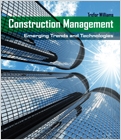Product Benefits: - Illustrations, tables, and charts supplement key information
- Scheduling coverage includes both basics of the CPM method, as well as the use of computers, offering both traditional and modern views of this key construction management concept
- Coverage of estimating offers discussions of both web-based estimating databases and the use of computer programs, emphasizing the increasing role of technology in the field
Table of Contents: 1. The Nature of the Construction Industry
Introduction to Construction. Some Statistics About the Construction Industry. Projects and the Construction Industry. Comparison of Construction and Automobile Manufacturing. Construction Project participants. Specialization within the Construction Industry. Emerging Trends in the Construction Industry. Megaprojects. Globalization. The US Transportation Infrastructure Crisis. The Importance of Ethics in the Construction Industry. Careers in Construction.
2. Methods of Delivering Construction Projects.
Introduction. Basic Construction Contractual Arrangements. Public and Private Owners: Construction Contract Types. Competitive Bidding.
Unit Price and Lump Sum Projects. Steps in the Competitive Bidding Process. Completion of the Design and the Development of the Bid Package. Advertising the Bid. Obtaining the Bid Package. Preparing the Bid. Design Changes During the Bidding Period. Pre-Bid Meetings. Submitting the Bid and the Bid Opening. Award of Contract Notice to Proceed. Bid Security and Bid Bonds. Bid Package Details. Specifications. General Conditions. Special Conditions. The Complexity of Bidding. The Importance of General Conditions During Construction. Change Orders. Time Extensions. The Ethics of Competitive Bidding.
3. Change Orders and Disputes during Construction.
Introduction. Change Orders. Changed Conditions. Design Errors and Omissions. Change in Project Design. Negotiating Change Orders. Contractor's Duty to Perform Change Order Work. Issues Related to Time and Delay. Liquidated Damages. Time Extensions. Resolving Construction Disputes. Dispute Resolution Boards and On-Site Neutrals. Arbitration and Mediation. Litigation. Partnering. Value Engineering.
4. Construction Management Contracts: An Alternative to Design-Bid-Build.
Introduction. Construction Management Contract Formats. Agency Construction Management. At-Risk Construction Management Contracts.
5. Design Build Procurement: Combining the Designer and the Contractor.
Introduction. Potential Benefits of Using Design-Build. The Design-Bid Process. The Request for Proposals: Defining the Project Scope. Competitive Procurement: One-Step and Two-Step Procurement. Preliminary Designs Included in the RFP. Formations of Teams and Consortiums. Additional Legal Risks for Contractors with Design-Build.
6. Emerging Trends in Project Procurement: Public Private Partnerships.
Introduction. Reasons for the Emergence of Public-Private Partnerships. The Structure of Public Private Partnerships. Build-Operate-Transfer. Design-Build-Finance-Operate. Examples of Public Private Partnerships. BOT Projects. DBFO Projects. Conclusions.
7. Cost Control, Profitability and Cash Flow.
Monitoring costs during construction. Assessing project profitability. Construction accounting and the profitability of the firm. Cash flow during construction. Unbalanced bids. Financing. Using computer softwa... |

